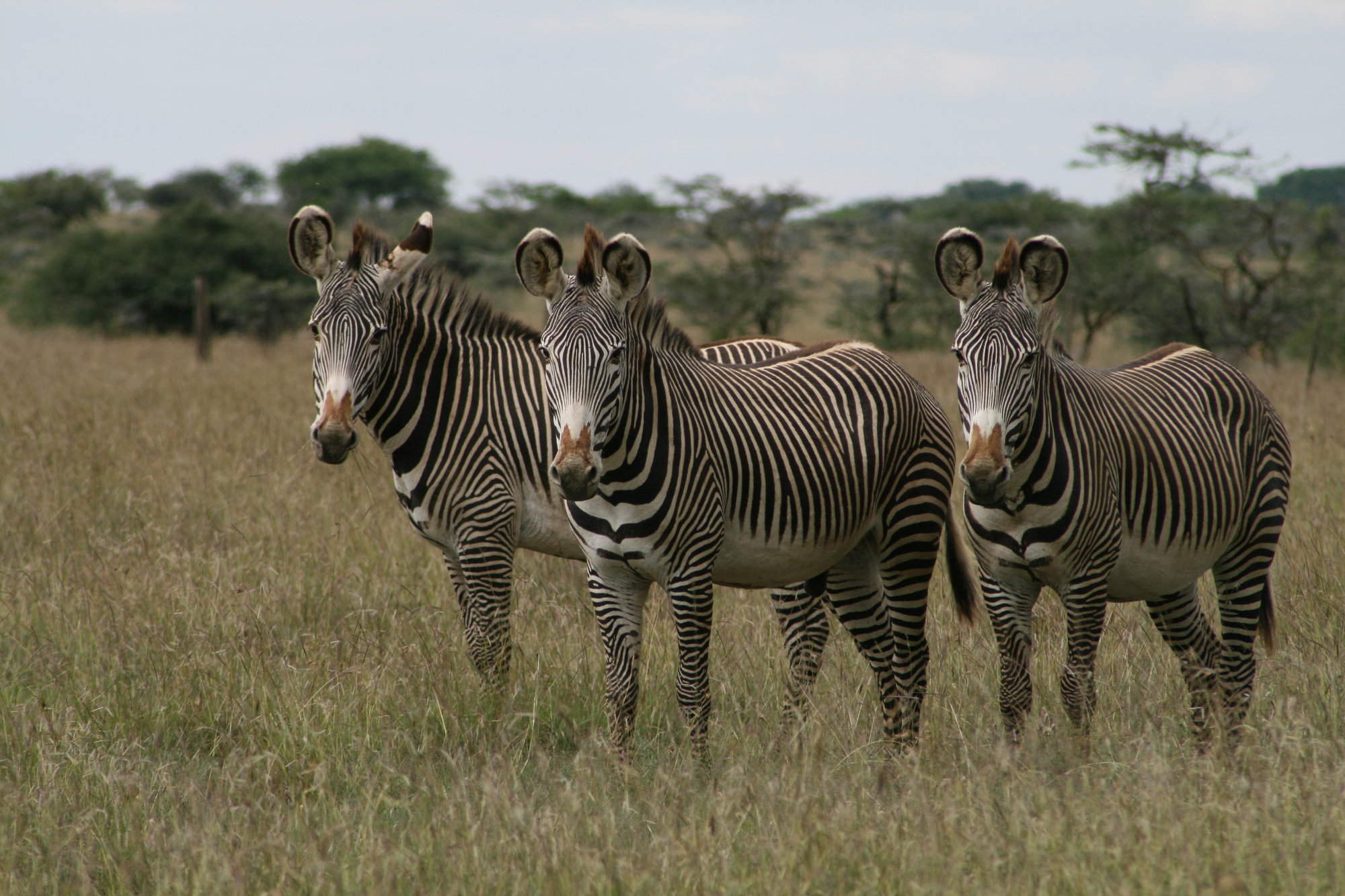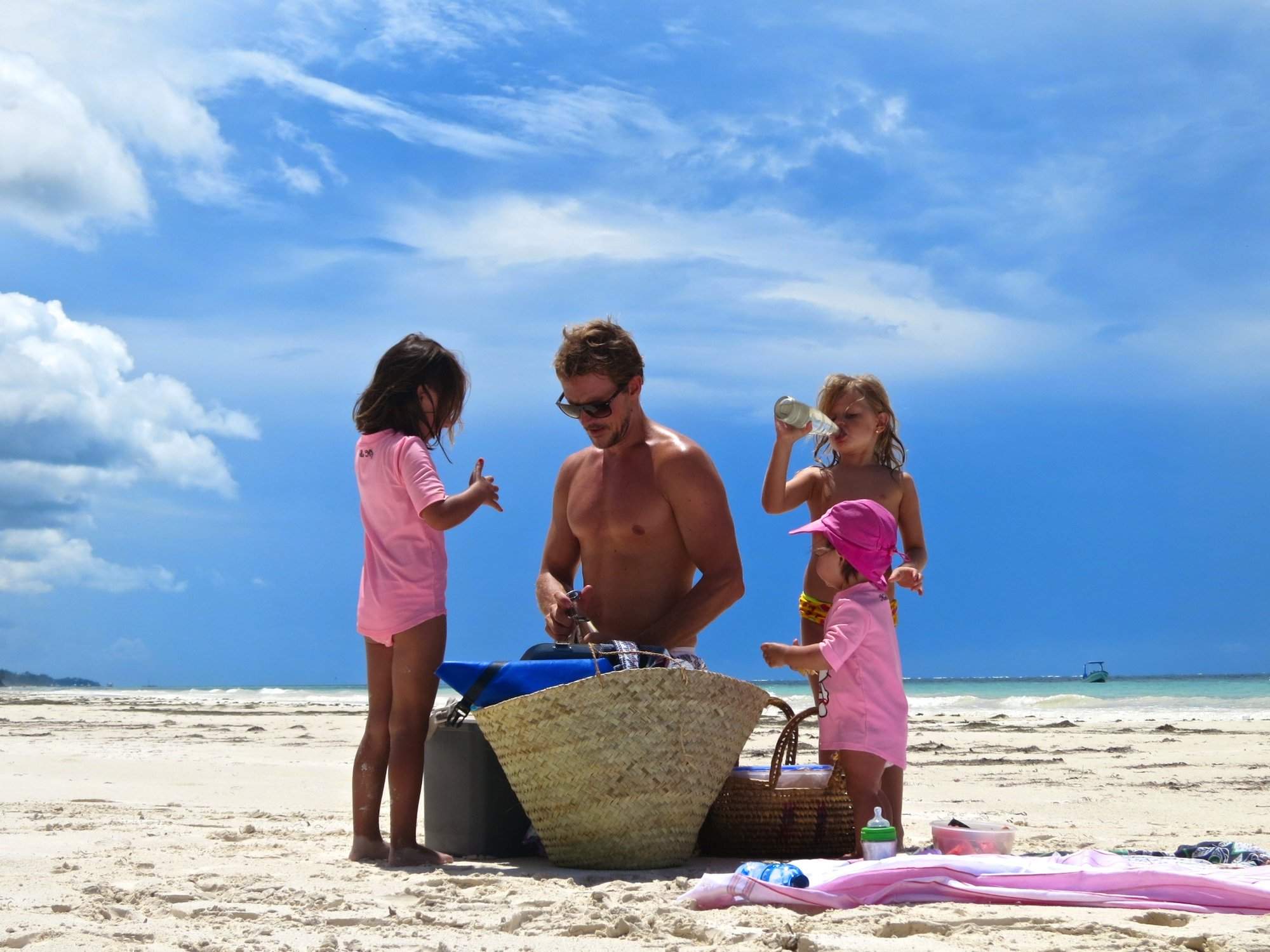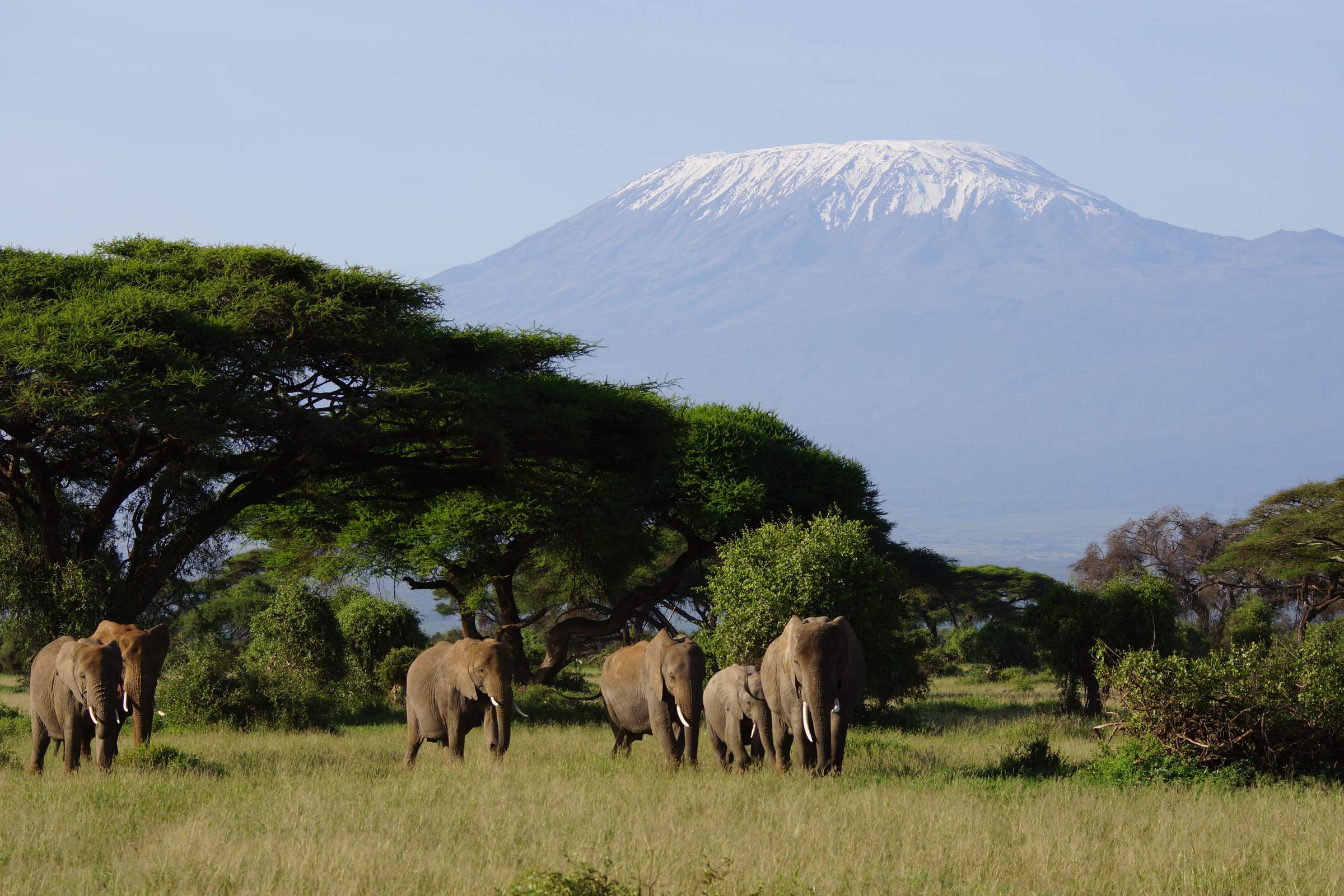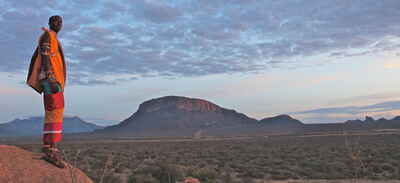
Samburu is home to plenty of wildlife, including leopards.
Dominating the landscape are rocky ridges, running north to south.
Samburu National Reserve
Samburu National Reserve
This small reserve is part of the homeland of the pastoral Samburu, who water their herds in the Ewaso Nyiro.
North of Laikipia, the hot, dry, relatively low country (around 800m above sea level) that heralds Kenya’s vast northern deserts and semi-deserts is the traditional homeland of the Samburu people, who were drawn to this region by the reliability of the Ewaso Nyiro, northern Kenya’s biggest and least seasonal river, for watering their herds. The wildlife is plentiful here for the same reason – dozens of species of plains grazers and browsers gathering in the thick acacia and doum palm forest along the river banks to drink and seek shade.
Focusing on the river banks and a few kilometres of dry bush on either side, the 104km² Samburu National Reserve is one of a pair of much loved reserves in northern Kenya, the other half being the 131km² Buffalo Springs National Reserve, on the south side of the river. Downstream, on the right bank and across the highway, lies the less well-known, 239km² Shaba National Reserve, with its gaunt scenery. A 24-hour entrance ticket to any one of the reserves entitles you to visit the others during the same period.
The Ewaso Nyiro and its tributaries flow north through Laikipia from the Aberdare range and Mount Kenya in the central highlands, and the main river then elbows east through a series of ravines, before tumbling out onto the sandy plains of the Samburu ecosystem and then meandering into the semi-desert beyond where it finishes in a vast seasonal marsh, the Lorian swamp. Although the river is almost perennial, it sometimes dries up in January or February. It’s equally prone to flood, however, and in March 2010 and again in November 2011 it burst its banks with dramatic consequences, inundating safari camps and sweeping away the main bridge linking Samburu and Buffalo Springs reserves. The bridge, near the reserve headquarters, remained broken until February 2015, when it finally re-opened.

Safaris visiting Samburu
Just ideas, we'll always tailor-make a trip for you

Steppe Eagle Fly-in Safari
7 days • 2 locations
NAIROBI AIRPORT TO NAIROBI AIRPORT
Two comfortable tented camps overlooking the Ewaso Nyiro and Mara River put you at the heart of the action. Experience spectacular diversity in species and habitat with safari in Samburu and the Masaai Mara National Reserve.
US$6,140 - US$9,310 per person
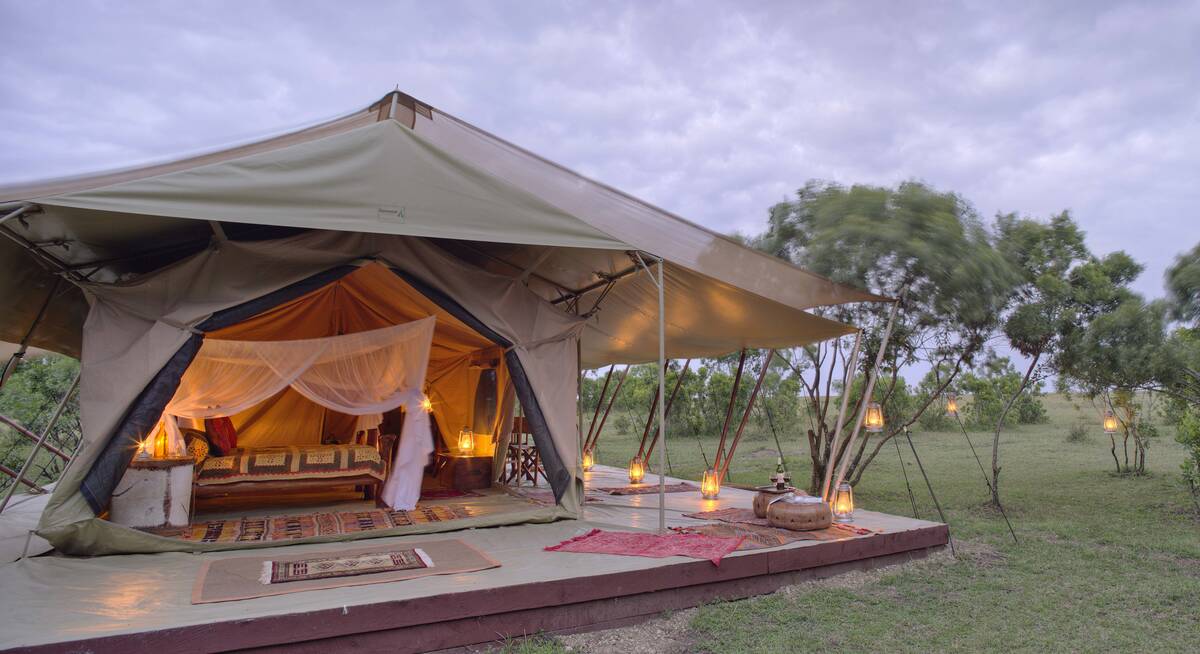
Lanner Falcon Fly-In Safari
8 days • 3 locations
NAIROBI AIRPORT TO NAIROBI AIRPORT
Three sister camps offer access to wonderfully remote regions across northern Kenya and the Maasai Mara ecosystem. Enjoy an exclusive safari experience focused on great wildlife, superb guiding and considerable comfort, with a range of activities.
US$7,140 - US$8,400 per person
Most recent reviews of our safaris to Samburu
Click below to browse all 74 reviews from Samburu National Reserve. All from our travellers; all are in full & unedited.
Arrived 31 Jan 2025, 12 nights
"My Jan 2025 trip"
Overall rating: Excellent
Arrived 19 Jan 2025, 11 nights
"Our Kenya trip January 2025"
Overall rating: Excellent
Arrived 19 Dec 2024, 17 nights
"Kenya - December 24"
Overall rating: Excellent
Arrived 17 Nov 2024, 14 nights
"My Nov 2024 trip"
Overall rating: Excellent
Arrived 22 Oct 2024, 8 nights
"My Oct 2024 trip"
Overall rating: Excellent
Arrived 18 Oct 2024, 11 nights
"My Oct 2024 trip"
Overall rating: Excellent
Arrived 4 Oct 2024, 11 nights
"My Oct 2024 trip"
Overall rating: Excellent
Arrived 4 Oct 2024, 16 nights
"My Oct 2024 trip"
Overall rating: Excellent
Arrived 24 Sep 2024, 12 nights
"My Sep 2024 trip"
Overall rating: Excellent
Arrived 15 Sep 2024, 11 nights
"My Sep 2024 trip"
Overall rating: Good
Where to stay in Samburu
Our suggestions for safari camps in Samburu National Reserve
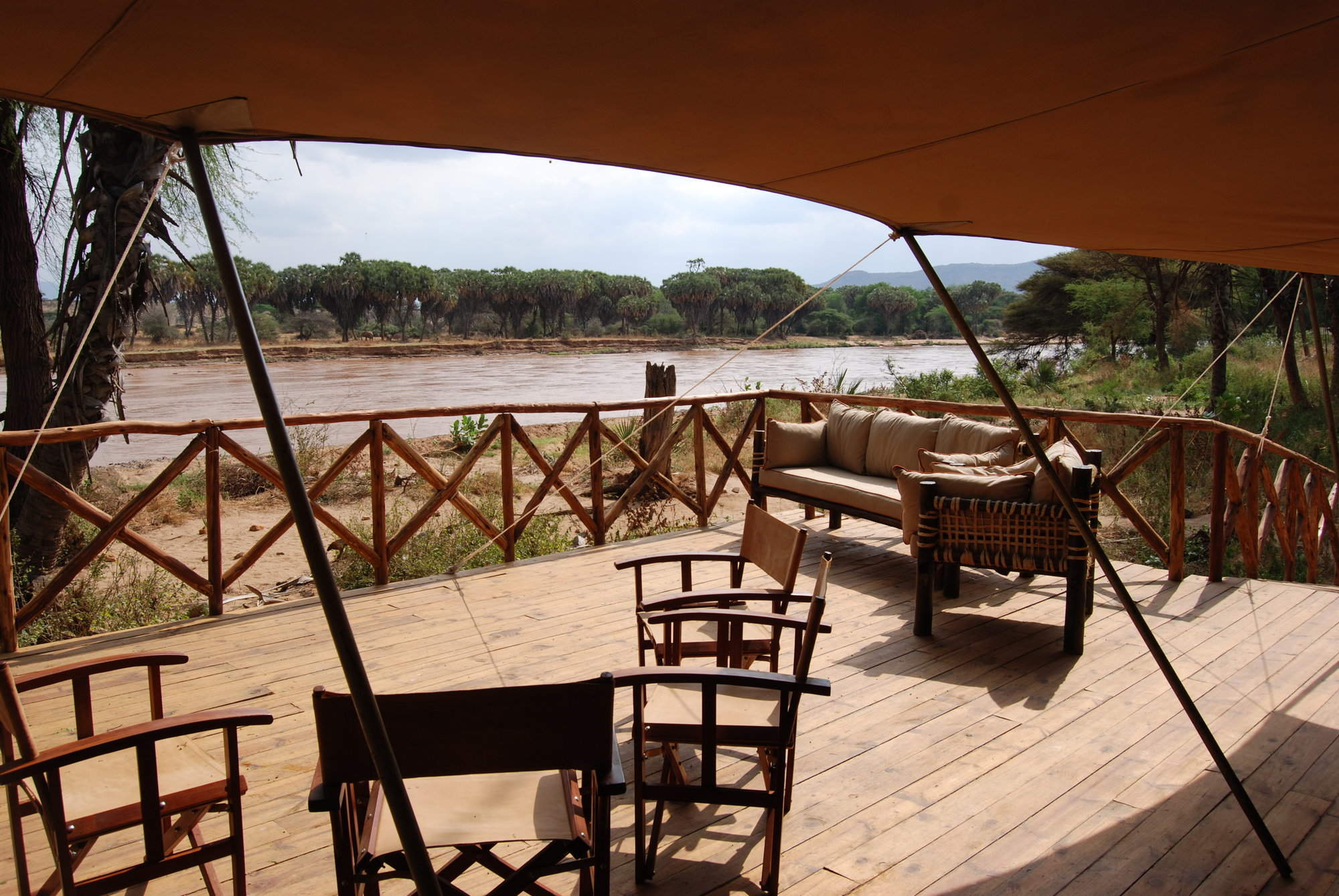
Elephant Bedroom
Elephant Bedroom is a smart tented camp in the heart of the Samburu National Reserve, offering a good degree of comfort without divorcing you from the beautiful natural environment.

Saruni Samburu
Saruni Samburu is a top-quality boutique lodge, with one of the most breathtaking locations in Kenya overlooking its own private conservancy.
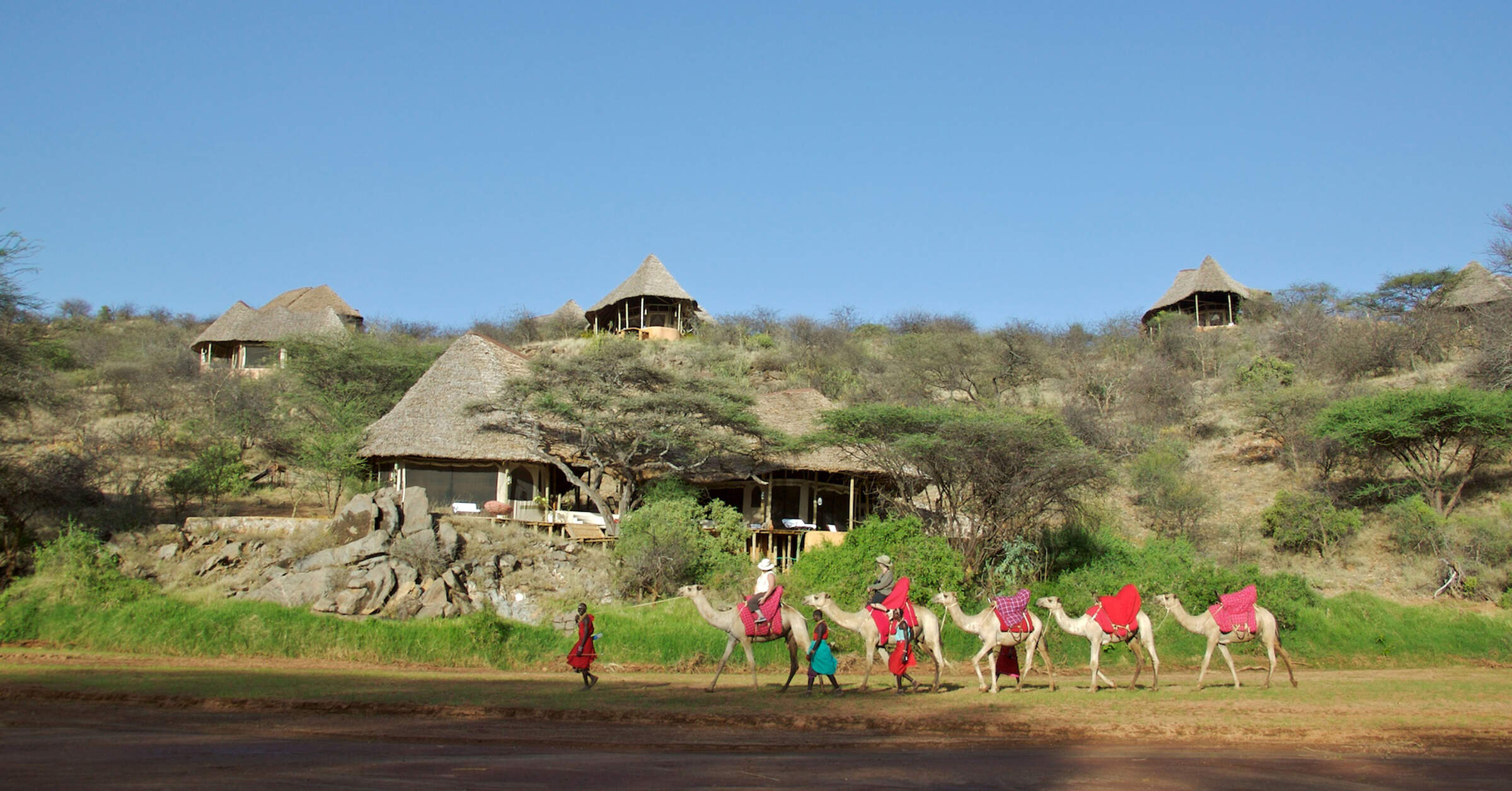
Sasaab
Stylish and luxurious Sasaab has nine rooms with stunning views across the Ewaso Nyiro River to the plains beyond.
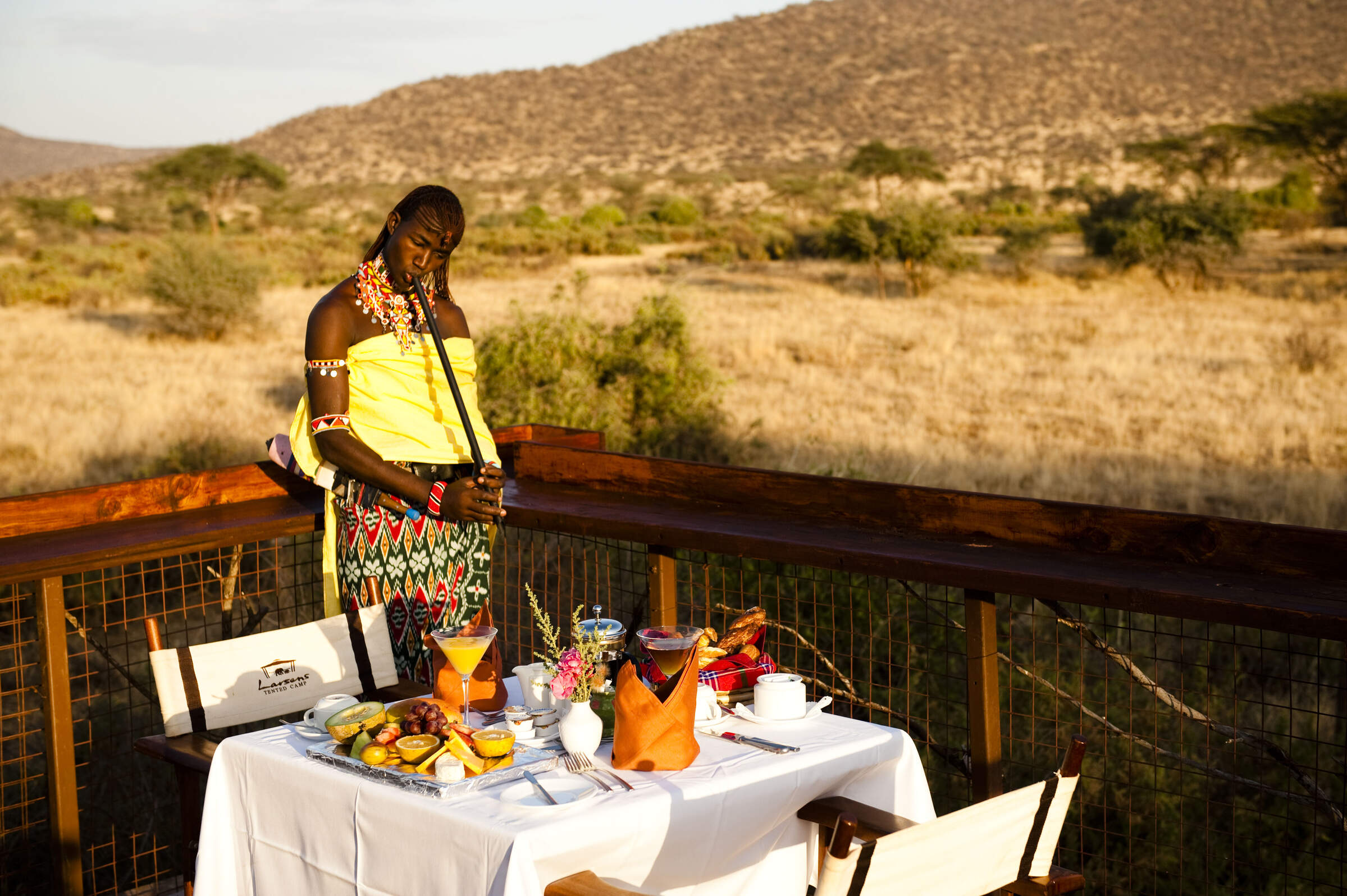
Larsens Tented Camp
Larsen’s Tented Camp is a relaxed and welcoming camp, with 20 sturdy tented rooms, a good pool and a very engaging team of staff.
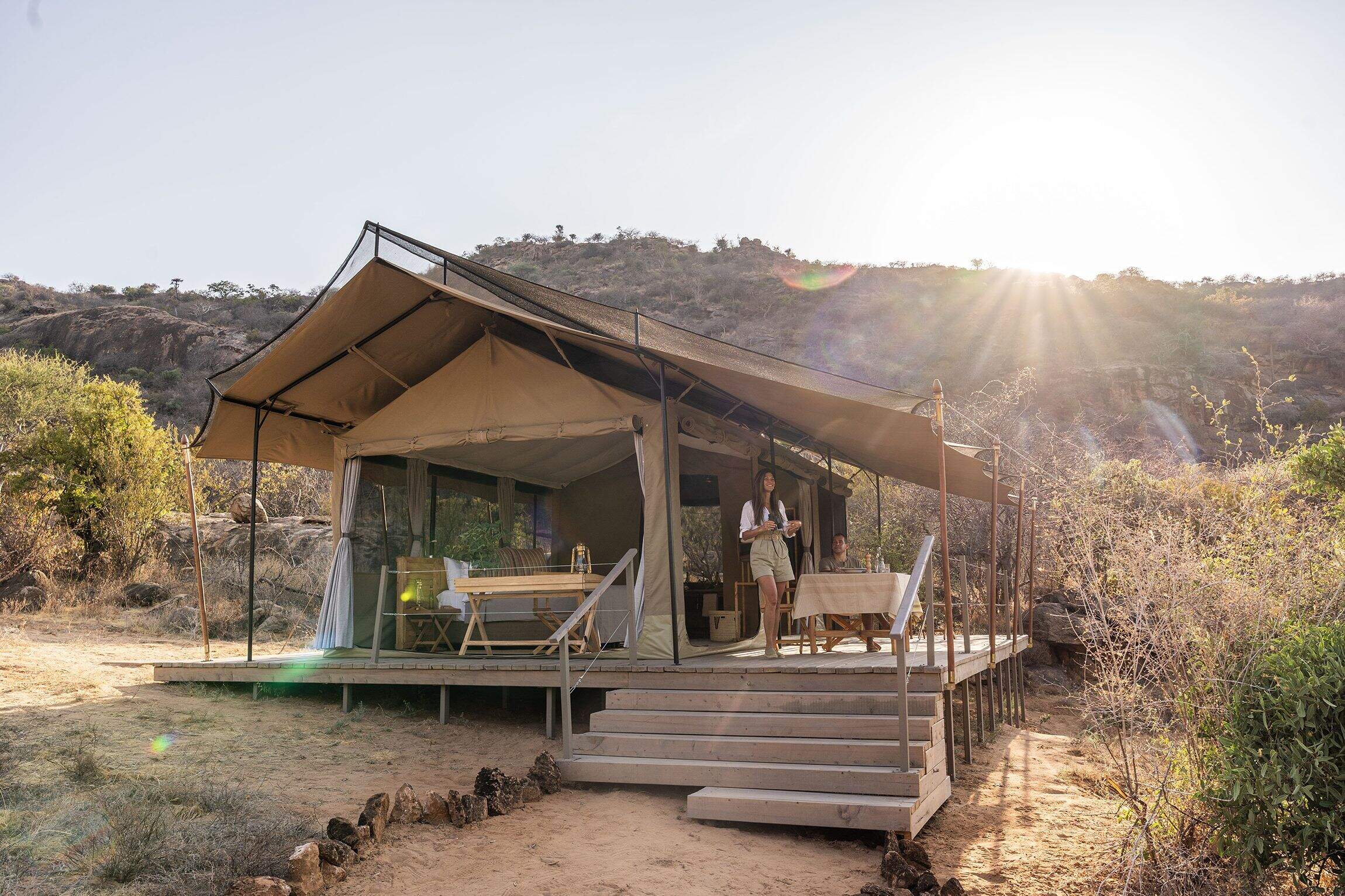
Basecamp Samburu
Basecamp Samburu is a smart tented camp offering an intimate safari within Samburu’s Kalama Conservancy and the surrounding reserve.
Our travellers’ wildlife sightings in Samburu
This is their success for sightings in Samburu National Reserve. Click on a species for more detail. How we work this out.

100% success

100% success

97% success

95% success

94% success

92% success

63% success

60% success

29% success

24% success

18% success

17% success

7% success

3% success

0% success

0% success
When to go to Samburu National Reserve
Our month by month guide: What it's like to visit Samburu in Kenya
Jan
Feb
Mar
Apr
May
Jun
Jul
Aug
Sep
Oct
Nov
Dec
Kenya in January
Clear, hot days and warm nights make this high season a popular time for safaris and it’s also good for diving and snorkelling as water clarity is excellent and gets better as the dry season progresses. Most lodges and tented camps treat January after the New Year week is over, as mid-season, making it a good compromise in terms of value for money with reasonably reliable, dry weather and some greenery left in the landscape.
Expert Africa bases its description of climate and weather in January, like the other months of the year, on the climate records of roughly the last 100 years, and it's fair to say that the weather and seasons since the beginning of this century have been highly irregular and unpredictable.
- On average, January is the second driest month of the year
- Elephants dig waterholes in the dry riverbed in the Samburu reserve.
- Wildebeest and many antelope have their calving season, to February.
- Migrant birds are seen in huge numbers, especially in the Rift Valley.
- Sea water clarity around the coral reefs generally good.
Our view
Fantastic: the very best time to visit
Weather in January
Kenya in February
With the short dry season well established, the grass grazed down and wildlife gathering close to water points, this is still a good time for a safari. Good water clarity in the Indian Ocean's coastal waters makes for excellent diving and snorkelling conditions.
Expert Africa bases its description of climate and weather in February, like the other months of the year, on the climate records of roughly the last 100 years, and it's fair to say that the weather and seasons since the beginning of this century have been highly irregular and unpredictable.
- On average, February is the driest month of the year.
- It’s sometimes possible to swim with whale sharks at Diani Beach.
- Migrant birds are still seen everywhere, especially near water.
- This is usually peak calving season for wildebeest and many antelopes.
- This month is often the hottest of the year, especially on the coast.
Our view
A very good time to visit
Weather in February
Kenya in March
Hot, increasingly humid weather – with good diving and snorkelling conditions at the start of the month – gives way to rains and lower accommodation costs. Expert Africa bases its description of climate and weather in March, like the other months of the year, on the climate records of roughly the last 100 years, and predicting the seasons since the beginning of this century has been difficult.
March is the month when – traditionally – intensely hot conditions build up until a cloudburst finally happens at the end of the month or in early April, to relieve the humidity. As ever, regional variations across the country can greatly impact on visitors' experiences.
- Sea-water clarity is best for diving before the long rains start.
- Visitor numbers are low, though the Easter holidays can be busier.
- Night skies can be scintillatingly clear in early March.
- Cropped down savannah grasses can make it easier to see the wildlife.
- Temperartures climb high, especially at lower elevations.
Our view
A good time to visit, with pros & cons
Weather in March
Kenya in April
April sees the full onset of the southeast monsoon wind or kusi, which heralds the long rains. Temperatures drop soon after the rains are established and you’ll often have facilities largely to yourself in this more affordable low season, sometimes known as the "green season". The bush quickly springs to life, with greenery sprouting almost before your eyes. While you're likely to get a fair number of heavy showers, the breaks in the rain can yield sparklingly clear conditions.
With the dust settled and bright sun piercing the clouds, conditions can be sublime for photography, especially first thing in the morning or in the late afternoon with another storm brewing. You may be lucky, or you may find conditions very wet and muddy.
- A wet month, the coast often gets more than 300mm (12in) of rain.
- Sunny spells can provide great light for photography.
- Buffalo and zebra calving season often happens in this month.
- Baby crocodiles hatch, for example on Central Island in Lake Turkana.
- Palearctic migrant birds gather to fly north to breeding grounds.
Our view
A time to avoid if possible
Weather in April
Kenya in May
While game viewing can be trickier as vegetation runs riot, between the cloudbursts the colours and light are great for photography at this time of year. Expert Africa bases its description of climate and weather in May, like the other months of the year, on the climate records of roughly the last 100 years, and while it's reasonable to expect heavy rains in many parts during this month, especially on the coast, the rains don't always come evenly or in some areas come at all.
In an El Niño year, the so-called long rains that normally are established across much of the country by May can be meagre, to the despair of farmers. On the other hand in a La Niña year, the long rains can bring floods. On the coast, the monsoon winds make the climate much more predictable, with heavy rains common throughout this month.
- Frogs breed in the ponds in the Arabuko Sokoke Forest near Watamu.
- Wildebeest, impala and other grazers are in rut (the breeding season).
- Kilimanjaro looks its best as heavy rain falls as snow on the summit.
- There's a sharp peek of rainfall on the coast with many rainy days.
- Accommodation prices are uniformly low, while some camps close.
Our view
A time to avoid if possible
Weather in May
Kenya in June
The rains give way to cloudy, cooler weather, often making for comfortable conditions by the end of the month, especially in the highlands. Starting from mid-June or the beginning of July and running until the end of October, this is the high season, and accordingly has higher accommodation rates and – at least until early September – higher numbers of visitors.
While the early part of June can often be rainy on the coast, it can be a great time to go on safari, with fresh greenery, many young animals and good photographic conditions with clear air.
- The Taru Desert, inland from the coast, is carpeted with flowers.
- The Lake Turkana Cultural Festival is held in Loiyangalani.
- Madaraka Day (commemorating self rule) is 1 June.
- The annual Lewa marathon runs a course through the wildlife.
- The Diani Rules "sports" event rips up the rulebook at Diani Beach.
Our view
A good time to visit, with pros & cons
Weather in June
Kenya in July
Kenya’s “winter" season sets in (winter is a misnomer but locals feel the change), and the highlands can be rather grey. Skies are often cloudy and the days can be surprisingly cool, with an average daytime high in many highland safari areas of 15-20°C and night-time temperatures dropping below 10°C in Nairobi and the highlands. Lower parts of the country and the coast are usually warm and dry, typically reaching highs of around 25°C with lows in the high teens.
As this is the start of the high season, coinciding with the usual arrival of the wildebeest migration in the Maasai Mara, July is a busy month. Ask your Expert Africa specialist to advise on how to avoid the crowds, which is not that difficult to do.
- The wildebeest migration usually reaches the Maasai Mara in July.
- Simbi Lake (Kisumu) and Crater Lake (Naivasha) can attract flamingoes.
- Watersports start to pick up and some surfing is possible at Malindi.
- Afternoon thunderstorms are a common feature in the Maasai Mara.
- The sea can be choppy along the coast, making diving difficult.
Our view
A good time to visit, with pros & cons
Weather in July
Kenya in August
The Great Migration fills the plains of the Maasai Mara, and school’s out, so the park roads are full of tourists – ask your Expert Africa specialist for advice on crowd avoidance tactics. Choose a private conservancy rather than a public national park or national reserve for quieter conditions.
Like July, August is generally mild and relatively dry in the safari areas, but it can be very chilly in the highlands, even in the middle of the day, and hail occasionally falls above altitudes of around 2,400m (8,000ft). Nairobi can be disappointingly overcast, with low cloud.
- Apart from Christmas holidays, this is the busiest month of the year.
- Late August sees peak wildebeest drama at the Mara River crossings.
- Coastal winds are good for kite- and wind-surfing.
- Few mosquitoes are around at this generally dry time of year.
- The annual Camel Derby takes place in the Samburu capital, Maralal.
Our view
A good time to visit, with pros & cons
Weather in August
Kenya in September
The skies clearing of cloud signals the start of hot, dry weather with little chance of rain – and, after the first few days of the month, far fewer visitors – making the latter part of September a good time for a quieter safari. While early September is often good for dramatic migration crossings along the Mara River, you might consider deliberately postponing your trip until later in the month, when the migration can still be very impressive and visitor numbers fewer.
If tourist surges are somewhat predictable, however, the patterns of the wildebeest migration are more volatile, and like all of Expert Africa's climate and weather assessments, they are based on accumulated years of experience rather than guaranteed certainty.
- This is still high season, with prices to match.
- Many river crossings take place on the Mara river in both directions.
- Natural bush fires flush out insects and small animals for predators.
- The Rift Valley Music Festival takes place by Lake Naivasha.
- With school holidays over by early September, late-month is quieter.
Our view
Fantastic: the very best time to visit
Weather in September
Kenya in October
Still hot, mostly dry and not too busy, this is many people’s preferred month for a safari, and it’s also good for diving and snorkelling. The wildebeest and zebra herds of the great migration are often still to be seen, though in dwindling numbers. The swamps of Amboseli attract thirsty wildlife including large herds of elephants.
While we wouldn't expect much rain across most of the country this month, the climate has become so unpredictable that you can never say never, and the possibiity of the short rains – usually associated with November to mid-December, starting early, can't be discounted.
- This month sees the tail end of the great migration in the Mara.
- Palearctic migrant birds start to arrive, staying until March.
- Turtle nests hatch at Watamu, until November.
- Amboseli elephants focus on the swamps for their daily water.
- The Indian Ocean monsoon winds turn from southeast to northeast.
Our view
A very good time to visit
Weather in October
Kenya in November
The northeast monsoon wind or kaskazi heralds the start of the “short rains", usually some time in the second half of the month. From November to mid-December, this is the low season, and accordingly has lower accommodation rates and lower visitor numbers. Across most of the country you can expect warm, somewhat cloudy weather, with occasional heavy showers and localised flooding.
Expert Africa bases its description of the climate in November, like the other months of the year, on the records of roughly the last 100 years, and it's fair to say that the seasons since the beginning of this century have been highly irregular and unpredictable: some years the short rains don't come at all, or don't reach every part of the country. In an El Niño year, the November short rains can be very heavy, but in a La Niña year, they can fail completely.
- Swimming with dolphins in Lamu can be done from now until April.
- Birders gather at Ngulia in Tsavo West to ring Palearctic migrants.
- The Lamu Cultural Festival takes over the town and Lamu Creek.
- Agricultural shows often take place regional market towns.
- This is low season, so camps can be great value, with special offers.
Our view
A good time to visit, with pros & cons
Weather in November
Kenya in December
In a typical December, the rains usually finish by middle of the month, leaving the landscape looking its best, under clear blue skies, and heralding the start of the second peak tourist season from around 20 December to the first week of January. Our assessment of the likely weather in December, like the other months of the year, is based on climate records, and it's fair to say that the seasons since the beginning of this century have been highly irregular and unpredictable.
Christmas can sometimes be wet, but most years the rains have finished a week or two earlier, with the festive season ushering in the perfect combination of clear skies and sunshine by day and starry nights.
- Christmas and New Year are busy, with the lodges and camps full.
- Rates are highest after 24 Dec, with supplements on public holidays.
- Republic Day and Independence day are celebrated on 12 December.
- Good kite- and wind-surfing restarts, with strong northeasterly winds.
- Mango season begins, providing excitement for primates and elephants.
Our view
A good time to visit, with pros & cons
Weather in December
Samburu National Reserve: In detail
Samburu National Reserve
Safaris in Samburu National Reserve
Game drives often follow the winding, sandy tracks close to the meandering river, where almost anything – from a pride of lions to a herd of elephants or a flight of graceful, leaping impala – can appear at any moment.
In the past, large variations in Samburu’s animal numbers (as the availability of water varies greatly through the year), have meant that wildlife viewing at Samburu could sometimes be disappointing. Our visits in the last few years in various seasons have, however, proved really rewarding, both in the variety and the numbers of the mammals and birds we’ve seen here.
Geography and landscapes of Samburu National Reserve
The Ewaso Nyiro River, while heading east, does so in a series of north-south loops, around the district’s rocky ridges and the meanders created by the river itself. The river is 50–100m across, shallow and dotted with sand bars. For much of the year, bigger animals can walk across, while in periods of drought, crocodiles and hippos bury themselves as far as possible under riverside overhangs, and elephants gouge wells in the dry river bed to reveal water.
From the south bank, the flattish Buffalo Springs Reserve rises very gently to the south, but there’s much more variety in Samburu National Reserve, which rises more steeply away from the river towards the Kalama Conservancy in the north.
Samburu landmarks
The permanent Buffalo springs, after which Buffalo Springs National Reserve is named, are the main notable feature of the southern reserve in the pairing, and two are now walled, while a third breaks onto the plain and forms a small marshy waterhole that flows into the Ewaso Nyiro. One of the walled springs provides the water supply for the nearby small town of Archer’s Post; the other was formerly a natural swimming pool. Swimming is now prohibited – occasional crocs and the presence of predators by the waterhole make it far too risky.
Flora and fauna of Samburu
On the large mammal front, Samburu is the key area for seeing all of Kenya’s northern varieties of plains game – the strikingly large, ‘pin-striped’ Grevy’s zebra, stretch-necked gerenuk antelope (often seen on its hind legs, browsing out of the reach of its short-necked relatives) the smartly fawn-coloured Beisa oryx and the seemingly designer-coated reticulated giraffe. All three species of big cat hunt in the reserves, with a good number of leopard always present in the wooded riverbank areas and several lion prides at home both north and south of the river and often using forest cover for their ambushes. Cheetah are harder to spot here, but reports from other visitors mean you will usually see them if they’re around. The dominant mammal of Samburu, however is the elephant, of which around 900 individuals spend all or part of their year in the reserve ecosystem, characteristically ‘engineering’ it with their massive strength – knocking over trees, ripping out saplings and gouging water holes in the sandy river bed when the river runs dry. Zoologist Iain Douglas-Hamilton has his research camp here and the Samburu elephants are now some of the most extensively studied in Africa, along with those of Amboseli National Park.
Birdwatching in Samburu
As well as the distinctive, blue-skinned Somali ostrich, which you’ll see stepping out across the plains, the Samburu ecosystem’s oasis of vegetation in this arid region supports a very wide range of smaller birds, and birdwatchers can expect to see several dozen species on the average game drive. You’re not likely to miss the big flocks of vividly plumaged helmeted and vulturine guinea fowl, while among the many birds of prey, pygmy falcon and martial eagle from opposite ends of the raptor spectrum are both easily seen, as are Kori, Heuglin’s and buff-crested bustards, and lots of weavers, shrikes, woodpeckers and flycatchers.
The Samburu people
Kalama and Westgate Conservancies
Map of Samburu National Reserve
Choices for where to stay in Samburu National Reserve
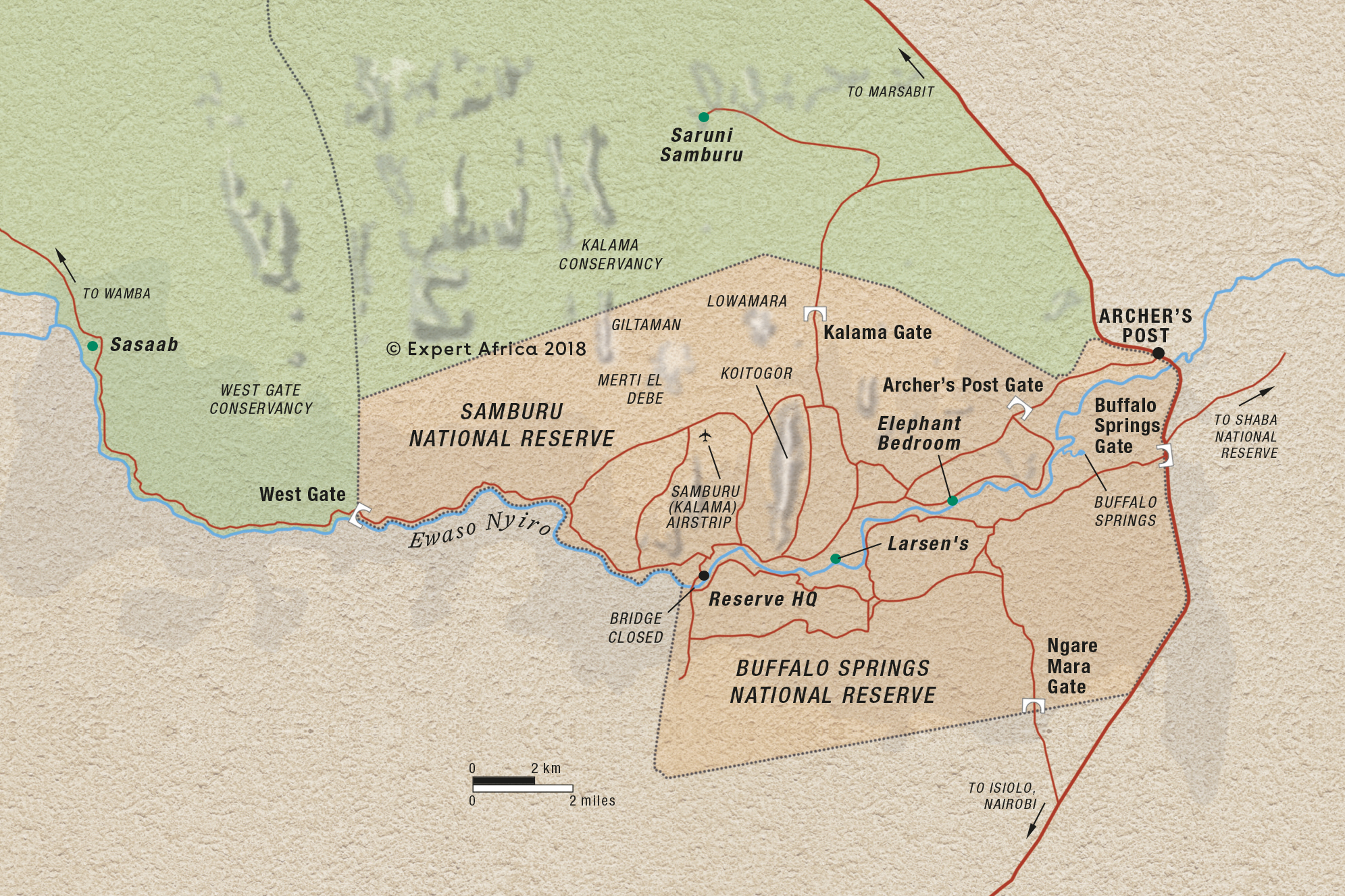
Samburu National Reserve: Safaris
The Samburu National Resrerve is one of Kenya's best-loved wildlife sanctuaries. In complete contrast to the rolling savannahs of the Maasai Mara, Samburu is arid country, its appeal to wildlife (and visitors) deriving from the Ewaso Nyiro river that runs through it - meandering past groves of forked doum palms with their science fiction appearance. Samburu has a wealth of wildlife in a relatively small area - elephants are legion and there are plenty of lions, leopards and cheetahs picking on the grazing antelope, zebra and other species drawn here for water and grazing. Our camps include several with riverside locations and an open-air tented lodge standing on solid rock in the dramatic Kalama Conservancy, just north of the reserve.

Steppe Eagle Fly-in Safari
7 days • 2 locations
NAIROBI AIRPORT TO NAIROBI AIRPORT
Two comfortable tented camps overlooking the Ewaso Nyiro and Mara River put you at the heart of the action. Experience spectacular diversity in species and habitat with safari in Samburu and the Masaai Mara National Reserve.
US$6,140 - US$9,310 per person

Lanner Falcon Fly-In Safari
8 days • 3 locations
NAIROBI AIRPORT TO NAIROBI AIRPORT
Three sister camps offer access to wonderfully remote regions across northern Kenya and the Maasai Mara ecosystem. Enjoy an exclusive safari experience focused on great wildlife, superb guiding and considerable comfort, with a range of activities.
US$7,140 - US$8,400 per person
Best 5 lodges and safari camps in Samburu National Reserve
There’s an increasing range of lodges and tented camps in Samburu, though in recent years they’ve often seemed too many for the number of visitors. Listed below are our recommendations for nice places to stay in this region. Ask us for more details of what's likely to suit you best!

Elephant Bedroom
Elephant Bedroom is a smart tented camp in the heart of the Samburu National Reserve, offering a good degree of comfort without divorcing you from the beautiful natural environment.

Saruni Samburu
Saruni Samburu is a top-quality boutique lodge, with one of the most breathtaking locations in Kenya overlooking its own private conservancy.

Larsens Tented Camp
Larsen’s Tented Camp is a relaxed and welcoming camp, with 20 sturdy tented rooms, a good pool and a very engaging team of staff.

Basecamp Samburu
Basecamp Samburu is a smart tented camp offering an intimate safari within Samburu’s Kalama Conservancy and the surrounding reserve.
Excursions in Samburu National Reserve
Optional, extra day-trips and excursions that are possible while you’re staying in Samburu National Reserve. Talk to us: these excursions are usually best arranged before you go.
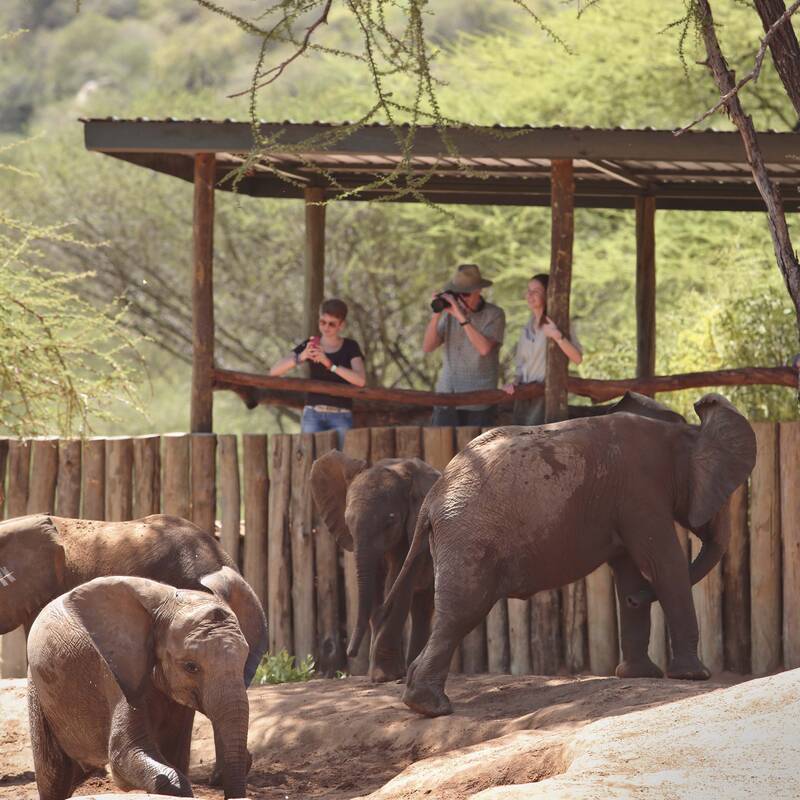
Reteti Elephant Orphanage visit
One-and-a-half hours, plus transfers
Visit the community-run Reteti Elephant Sanctuary in Samburu, for an intimate experience meeting the orphaned baby elephants who have been rescued from the surrounding regions. They are hand-reared by Samburu keepers, until they are ready to be released back into the wild.
More about Reteti Elephant Orphans
Looking for inspiration on where to travel next?
Visit our trip chooser to explore your options and find inspiration for your perfect African adventure
Inspire me

